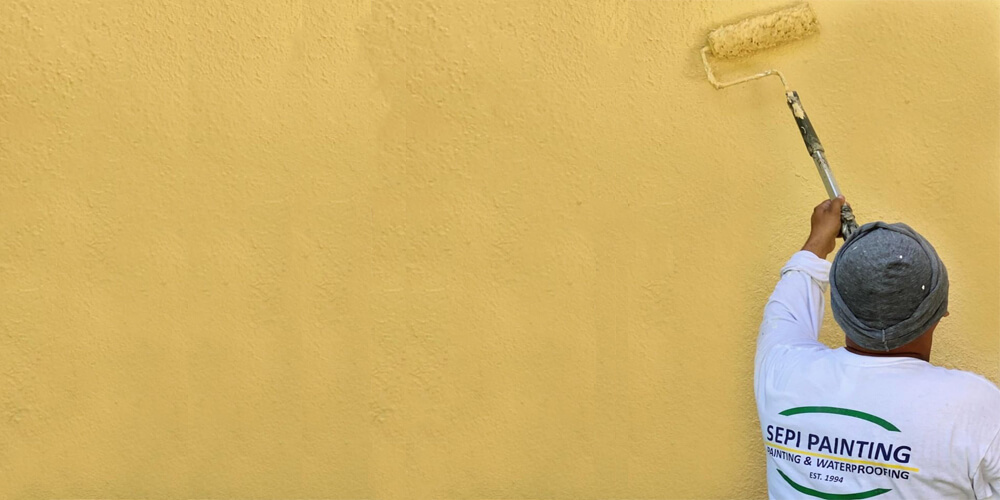PCA Articles

10 Insider Painting Tips That Even The Pros Won’t Tell You
Every painter has their own methods and preferences that may differ slightly from one another, but the professionals know all of the trade secrets.
1. Sand away flaws. A perfectly painted wall or woodwork starts with a perfectly smooth surface. Some pros spend so much time pushing sandpaper, that the title Sander may be more fitting. The sanding process starts with leveling out any spackle or joint compound patches to flatten possible nail hole ridges along with removing burrs and rough spots in the trim.
The walls from the baseboard to the ceiling should be sanded with a fine-grit paper on a sanding pole. The baseboard and ceiling should be sanded in a horizontal motion. Don’t put a lot of pressure on the sanding pole, or else the head can flip over and ultimately damage the wall. Woodwork should be smoothed with a sanding sponge to reach every crevice.
2. Invest in the best supplies. You should never go with the cheap option for paint and brushes, those are false economy. A Wooster or something with some heft will make your whole job quicker and easier. A plastic brush that costs a few dollars will make your walls look like the paint was smeared on with a rake. A 2 and 1/2-inch angled brush is very resourceful to be washed and reused even until the bristles become worn down to a nub.
The most expensive paint will go on easy, offer the best coverage and last a long time. It pays off in the long run when you have to wash off a grubby fingerprint without taking the paint with it.
3. Protect furniture. If you are unable to move furniture out of a room, move it all to the center of the room instead. This way, you can cover and wrap it with plastic sheets that are taped at the bottom. This protects your furniture from paint drips and splatters, as well as from sanding dust.
4. Use a tinted primer. When the pros paint walls, they will first fill holes and patch cracks with joint compound. But don’t make the mistake of painting directly over it, or the compound will suck the moisture out of the paint, giving it a flat and dull look. This problem is referred to as “flashing”. To avoid spots looking noticeably different than the rest of the wall, prime the walls before painting.
Instead of a white primer, pros will usually have it tinted grey or a similar color to the finish paint. This way, the primer will do a better job of covering the existing paint color and the finish coat will require fewer coats to be more vibrant.
5. Use a putty knife to press tape. To avoid scraping off paint that has bled through the tape, do a thorough job of adhering the tape before you start. Run a putty knife over top of the tape application to press down and get a good seal.
Blue painters’ tape is always a better option over masking tape. Masking tape tends to leave behind a sticky residue that’s hard to clean off and the tape itself can buckle or become wavy. This will allow for paint to seep through and run underneath. Painter’s tape is designed stop paint bleeds and be left on for several days at a time, some can even last for weeks and still peel off cleanly.
6. Paint extenders eliminate brush and lap marks. A paint extender, also called a paint conditioner, is the secret to a finish that is free of lap and brush marks. It will slow down the paint drying time, allowing for a longer window to overlap newly painted areas without getting ugly lap marks that are common when you paint over dried paint.
Paint extenders will also level out the paint, so brushstrokes are much less obvious if not eliminated completely. Pros use extenders to paint drywall, woodwork, cabinets, doors and more. You can read manufacturer’s directions to find out how much to add per gallon of paint.
7. Scrape a ridge in textured ceilings. Painting along the edge of a textured ceiling is almost guaranteed to give you a bumpy line along the top of the wall. The pros will run a screwdriver along the perimeter of the ceiling to scrape off that texture, creating a tiny ridge in the ceiling so the tips of your paint bristles naturally go in it. You’ll never even notice the missing texture and you’ll be able to get a straight line along the top of the wall without getting any paint on the ceiling.
8. Use a canvas drop cloth. The pros know better than to use a bedsheet as a drop cloth. Thin sheets will let splatters and spills seep through to your floors. Plastic tarps can contain spills, but the paint on top will stay wet for a long time, usually finding the bottom of shoes and tracking paint throughout the house.
Canvas drop cloths are not slippery and will absorb splatters. You should still be cautious to wipe up larger spills since those are not safe from bleeding through. You don’t need a jumbo-size cloth to fill the entire room unless you are painting a ceiling. A canvas cloth that is a few feet wide and runs the length of the wall will work perfectly to protect your floor and as an added bonus, it’s easy to move, too.
9. Wait until one wall is finished before starting another. You may think it’s easier to paint all the corners and trim in the room before going back to roll the walls. But the pros get a seamless look by cutting in one wall and immediately rolling it before starting the next. This allows for brushed and rolled paint to blend together. Some pros may not follow this technique for the sake of time, but this is a surefire way to achieve a professional look.
A helpful tip is to cover your paint bucket, tray or container with a damp towel when switching between brushing and rolling. This will keep your paint and tools from drying out when not in use.
10. Tape the windows too! Some pros believe that when painting sashes, if you just let paint get on the glass, once it is dry it will peel off in seconds with a razor blade. However, with the proper brush and technique, there is no reason for paint to end up on the glass Just be careful not to break the paint bond between the wood and the glass, or moisture can get in the wood and cause rot.
If you are about to embark on a home makeover journey that involves a new coat of paint or two, then you need the lockdown on paint-related items from rollers to primers and everything in between. These are the tips and tricks that the professionals use in order to turn ordinary walls into smooth and polished canvases.
About the author:

Rick Hernandez’s career in the painting and coatings industry started with a part-time job at Sears Roebuck and Company, and then quickly grew to an Assistant Store Manager at Sherwin Williams Co.
When hurricane Andrew hit South Florida on August 24, 1992, he decided to open his own company and in October of 1994 Sepi Corp. was born. The growth of Sepi Corp. went much better than anticipated. The new company was able to service both residential and commercial work.
A few years later, the company was rebranded, and the name was changed to Sepi Painting and Waterproofing, Inc. which aided in marketing and lead to additional growth. As the years passed, services were added, such as: waterproofing, electrostatic painting, and chemical.
Many of the tips listed in this article can be found in the Trade Best Practice series. Click HERE to get your crew started!